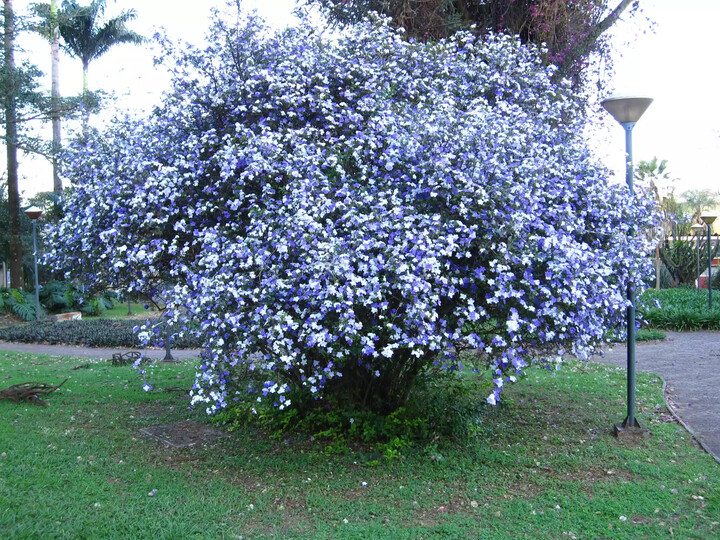The yesterday-today-and-tomorrow plant might be one of the longest plant names there is, and the name fits for more than one reason. The flowers change their color from one day to the next, starting out purple, then turning lavender, and finally becoming white as they mature. Plus, this tropical evergreen shrub is a long, persistent bloomer. After the first, heavy bloom in the spring, it will produce more of its showy, fragrant flowers in the fall, or anytime during the year if it likes its location.
In cooler climates, Brunfelsia can only be grown as a container plant that needs to be brought indoors for the winter.
Botanical Name :Brunfelsia pauciflora
Common Name :Yesterday-today-and tomorrow plant, Morning-noon-and-night, Kiss-me-quick, Brazil raintree, Franciscan raintree
Plant Type :Perennial shrub
Mature Size :Three to eight feet height, four to six feet width
Sun Exposure :Full sun to part shade
Soil Type :Sandy, silt, loamy
Soil pH :<6.0 (acidic)
Bloom Time :All season bloom
Flower Color :Purple, lavender, white
Hardiness Zones :9-11
Native Area :Brazil
Toxicity :Toxic to pets

Brunfelsia Pauciflora Care
If your local climate allows it, growing Brunfelsia in your yard is easy. But even if you can only grow it in a container, it requires relatively little maintenance.
Light
In its natural habitat, yesterday-today-and-tomorrow grows in light woodland and thickets with partial shade where it is protected from the scorching sun. An excellent location to plant Brunfelsia is under the canopy of tall conifers that give it enough room to reach its mature height.
Soil
The soil should be moist, acidic, and fertile, with a high amount of organic matter and good drainage.
Water
Whether you grow Brunfelsia outdoors or in containers, it is essential that the soil is consistently moist but never soggy. Water as needed and never let the soil dry out.
Potted plants need daily checking especially during the summer. In the winter, the indoor plants will go dormant and take up less water, which means you need to reduce the watering accordingly.
Temperature and Humidity
Because Brunfelsia is a tropical plant, it thrives in a humid environment.
Fertilizer
Before you add any fertilizer to an outdoor Brunfelsia, test the pH of the soil around the plant. If it turns out your soil is not acidic enough, apply liquid fertilizer for acid-loving plants but use about half of the strength indicated on the fertilizer label. If the soil is in the correct pH range, below 6, it always benefits the plant to add an acidic mulch such as peat moss or pine needles. This can help prevent the leaves from yellowing.
Container plants have higher fertilizer needs so feed them about every two weeks during the growing season, then stop fertilizing them during the winter and restart in the early spring.
Is Yesterday-Today-and-Tomorrow Toxic?
All parts of Brunfelsia, a member of the nightshade family, are poisonous to cats, dogs, and horses. Although there have not been reported cases of poisoning in humans, it is not recommended for homes with children who could be tempted to ingest the berries that appear on the shrub in the winter.
Pruning
Brunfelsia is a slow grower and pruning is not essential. However, to encourage bushiness and give the mounded shrub a neater appearance, remove all the spent flowers and give the plant a light overall trim after the spring bloom.
When grown in containers, pruning is key to keeping the plant at a manageable size. Wait until is it finished blooming, then cut back all the stems by about half.
Repotting
When grown in containers, the yesterday-today-and-tomorrow requires regular repotting. In the spring, inspect the root system to see if it fills the pot and plant it in a larger pot with fresh potting mix.
Yesterday-Today-and-Tomorrow Varieties
Brunfelsia pauciflora ‘Floribunda’ is a profuse bloomer with deep violet, then light violet, and eventually white flowers.
Brunfelsia pauciflora ‘Compacta’ is a dwarf cultivar that does not grow taller than five to six feet.
Overwintering
If you bring the plant indoors for the winter, make sure it gets three to four hours of sunlight every day.
You can increase the humidity by placing the plants on water-filled trays with pebbles.
Common Pests/Diseases
Aphids can weaken the plant by sucking its sap. Unless there is a heavy infestation, they can be removed by gently washing them off with water. Other than aphids, there are no reported common pests or diseases.